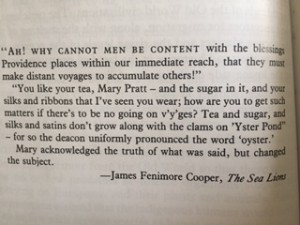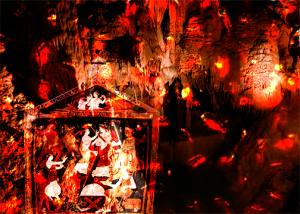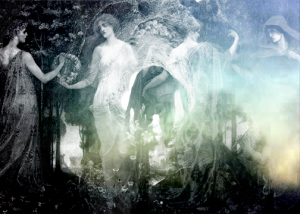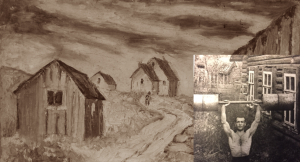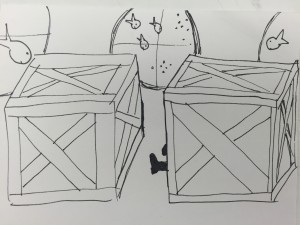All posts by Sophia Wilansky
Link to scenes: https://drive.google.com/a/williams.edu/folderview?id=0B4_bx6AvnsJqSWwzVDhSSEpqSkE&usp=sharing
Keep it leave it want it
Keep it:
I want to keep the idea of mediation between performers and audience (excluding the commonplace mediation of the proscenium). For example: the Sryia piece, the false memory piece, the coca flower piece, Bailey’s box, Kimmy’s silhouette.
Leave it:
I want to leave the inconsistency, both of having our individual artworks combined in one room, and of not having unified them into a theme or narrative, or any kind of comprehensible linear(ish) experience. I think that we should narrow down our interests to 2-4 central themes (or coherent groupings of themes) and temporarily split into groups to create more focused material. We spent the first third of the class generating a lot of material in an arbitrary way, and I think that what we have so far is not in any way “the show” because there is no real intention behind it yet. While many of the performances have promise to be expanded, revised, and connected to each other, the other objects are more like tools that don’t stand on their own in a performance context.
Want it: Track-Based Immersive Theater
I want us to consider creating a unified audience experience. Even if each individual spectator has a totally unique experience in the sense of seeing separate performances in different orders, every single one would fit into the same “world”. As I mentioned on the first day I’m interested in immersive theater, but I can’t really add this in this section because we’ve already been creating immersive theater! But to be more specific, I would like us to consider creating a piece in which the audience is split up and has unique experiences–we could picture these as puzzle pieces that they can cognitively build into the world of the performance, even if they don’t finish the whole puzzle! Those of you who were in or saw Fefu has some idea what I’m talking about with regard to separating the audience, but that was a VERY tame example. I’m thinking more of an immersive performance called Then She Fell, in which each audience member takes a different pre-defined track and spends a lot of time 1-on-1 with the performers. To give some examples, I brushed someone’s hair, I had to put together pieces of a letter, I had to take dictation, and there were small amounts of food and drink offered.
This kind of diversity and separation would give each person a lot of autonomy in crafting their character/portion of the world/interaction with the audience. Anything we do with the audience, with that much attention devoted to them, would turn out to be really interesting. I think that a formal challenge in this vein would go very well with the work we have already created. Please take this suggestion in the broadest way possible, I think the underlying idea is for us to center the spectator (individual and/or intimate groups) in the entire performance. We (or likely DGM) can make a more specific challenge if we want.
Reflect + Write (Sophia)
Emerging themes:
- Being demanding on the “audience” was a feature (in form and content) of most of the performances from the last assignment and most performances we’ve done so far in general. Putting people in total darkness, hand-feeding them, having them read aloud, making them fill out forms, taking them up to high vantage points, etc. Tending towards “immersive theater” which I mentioned on the first day! But how demanding can we be with non-classmates participating?
- Childhood/nostalgia, as seen in Phoebe’s juxtapositions, Omar’s ELI5 and triptych, Madeline’s “Candysand” and “AAAAA PPPPRINCESS?”, Omar’s “Land Before Time”, David’s “Three Little Pigs” and “Toy Story”, Bailey’s “Spy Kids”, Kimmy’s “Don’t Forget Your Mission (Thanks Yonce)” and “A Summer of Sisterhood”, etc.
- Eerie atmosphere, as seen in Molly’s triptych, Bailey’s triptych, Bailey’s 5 senses, Carina’s juxtapositions and Bailey’s mask, Gabrielle’s juxtapositions, my cosmic egg (or potato as people were calling it), probably my Gnosticism triptych, etc. In general the most memorable things were either creepy or funny, or both.
Things made by me:
- “The Job Hunt of David Carter” – I think there’s a lot more to that story, and I really liked the aesthetic of the Osaka Red Light District combined with the existential dread of not being worthy of hiring. #latecapitalism
- “Descent/Ascent” – Again I like the aesthetic I came up with, combined with the performance history significance of the Demeter/Persephone/Hades myth as the initiation rite of the Eleusinian mystery cult… I sense an affinity with Bailey’s 5 senses here.
Things made by others:
- Bailey’s triptych – because of the strange experience of being 14 disembodied heads.
- Omar’s spoken word (and haiku readings) – because they were so amazingly hilarious and I want to laugh that hard again.
- Paige’s juxtapositions – because it engaged with this foundational (to Western culture) story in such an original and nuanced way.
5 Senses
ELI5: Gnosticism
Gnosticism is an umbrella term for a variety of sects that may have predated Christianity (the exact origin, and whether it was “Western” or “Eastern”, is hotly disputed) but arose as a coherent religious movement in opposition to early Christianity, and largely faded away within a few centuries. As an esoteric (and often elitist) religion Gnosticism is connected to polytheistic mystery religions and to mystical forms of both Abrahamic monotheism and dualism (Manichaeism, Zoroastrianism, etc.)
While there were many people who considered themselves Christian Gnostics (and some who still do!), the Church has always considered Gnosticism heretical, especially because it positions direct experiential knowledge of the divine (insight, enlightenment) as the key to salvation from material existence. Gnosticism and Christianity share the idea of an imperfect world caused by a “fall from grace”, but where Christianity places the blame on sinful humans, Gnosticism puts it on a flawed divine being. While there are some pretty weird things going on in every Gnostic tradition, it is an interesting twist to have humans bear no ultimate responsibility for their own suffering.
Gnostics consider the entire material world to be at least imperfect and corrupted or even evil. There was never a Garden, a perfect expression of the material world. There is a singular, supreme God/monad who does not “create” anything but rather emanates similarly immaterial beings called æons, which only descend to the material plane through a mistake, flaw, sin. While in one sense everything is an emanation of God, the plane of existence that we live on is so twisted that we can consider it completely separate from the ideal, purely spiritual and immaterial world of Pleroma (Fullness). God is then transcendent rather than immanent, and it would be a mistake to worship nature or other deities contained within this world.
The creator of the material world is called the demiurge (a term borrowed from Plato, I think), who may mistakenly believe that he is God and have servants called archons (roughly analogous to angels or demons, and linked to specific celestial bodies). Gnostics have spent a lot of time making detailed classifications of æons and archons. Æons often come in male-female pairs called syzygies–Jesus and Sophia [okay maybe I had an ulterior motive for choosing this topic] are sometimes the lowest-level syzygy, most connected to the material plane. Other times Sophia is the æon which emanated without a male partner, resulting in the demiurge.
Given its conception of the entire material world as fundamentally corrupt, Gnosticism generally does not offer rules for moral or ethical conduct, leaving this to the individual to decide for themself. Still, many Gnostics looked to Seth (the 3rd son of Adam), Jesus, or Mani as savior figures. Ultimately, release from physical existence could only be achieved after death (and reincarnation would often be the consequence of not acquiring enough insight during one’s life), by overcoming physical existence, somehow undoing the mistake of creation, and returning to the Godhead (Spirit, Fullness, Profundity).
In 1945 actual Gnostic texts were discovered in Egypt; these and other texts which have since been discovered include many additional and alternative narratives to the New Testament. One can imagine why the Church, seeking to assert a single authoritative version of Biblical myths, was so threatened by the proliferation of alternate texts, ideas, and cosmologies that sought to operate both within and without the framework of existing religions.
Sources:
“Gnosticism.” Early Christian Writings. N.p., n.d. Web. 23 Feb. 2016. <http://www.earlychristianwritings.com/info/gnosticism-cathen.html>.
“Gnosticism.” Early Christian Writings. N.p., n.d. Web. 23 Feb. 2016. <http://www.earlychristianwritings.com/info/gnosticism-wace.html>.
“Gnosticism.” Theopedia. N.p., n.d. Web. 23 Feb. 2016. <http://www.theopedia.com/gnosticism>.Hoeller, Stephan A. “The Gnostic World View: A Brief Summary of Gnosticism.” The Gnosis Archive. N.p., n.d. Web. 23 Feb. 2016. <http://gnosis.org/gnintro.htm>.
“What Is Christian Gnosticism?” GotQuestions.org. N.p., n.d. Web. 23 Feb. 2016. <http://www.gotquestions.org/Christian-gnosticism.html>.
Juxtapositions: The Job Hunt of David Carter
David Carter had a long day of job-searching in the City. He didn’t have any official interviews but rather was wandering between office buildings, harassing anyone in professional attire, trying to convince them that if they would just give him a chance he would be a great asset to their company. He would! A few months ago he had graduated from one of the best colleges in the world, so he was certainly qualified to sit around in a suit making loud phone calls and pretending to be a productive member of society. His father was supporting him in the meantime, but every day he pressured David to get a job. How hard could it be? Sure, the economy was on the verge of collapse, but David was so special, so smart. He would be fine.
When the business day ended, David was too embarrassed to go home. No, he wasn’t going to sit at the dinner table and listen to his father pointedly talk about how easy it was to get a job back in his day. This is it, he said—this is the day I get a job. What do businessmen do when they get off of work? Drugs and sex, he guessed. And so David decided to go to the Red Light district.
He was immediately assaulted by the irritating multitude of ads and the suffocating throngs of tourists. He had a drink at a bar and regretted it—David could not really afford to drink, especially not overpriced tourist cocktails. While waiting at an intersection for what seemed like forever, he caught the eye of a beautiful woman across the street. She seemed different from all the other women, purer perhaps, a little more real. She seemed a little sad or maybe just calm, like she was at peace with the world.
When the light turned green they went into the alley behind a noodle bar and had sex—David could not really afford this either, but luckily she had a credit card reader on her smartphone. He took her to a sleazy hotel, where they had more sex. He wished he could get to know her as a person, but thought that might be too awkward.
Just after midnight he ran ten blocks to the nearest station to catch the last train home, but it departed 2 minutes early while he was still waiting in line for a ticket. He would have to wait for the 5:07am.
He went back outside, dead quiet save for the McDonald’s down the street. He walked slowly towards the mesmerizing yellow arches towering above. Then he walked through the door and up to the counter. He asked if they were hiring for any managerial or consulting positions. They were not. How about fry cooks? No, they were still not hiring. Would he like to order? David ordered a Big Mac and a Diet Coke. Would he like fries with that? No, he would not—yes, he would—two orders of fries! And: an order of chicken nuggets! Put it all on the card–why not? He’d be in debt for the rest of his life anyway if he didn’t find a job.
David went upstairs to find a table. Everyone looked just as awkward and tired as him, but he was the only one in a suit. The businessmen all had offices to sleep in; they didn’t have to sit in the fluourescent purgatory of a fast food establishment. Kindred spirits, all waiting for the 5:07, or the 5:23, or the 5:49 out to their village, or perhaps, if they were lucky enough to have a job, waiting for their morning shift. They all know, he thought. They all know I have no job and they all know that I’ll never have a job.
The man at the next table fell asleep, his face buried in a hamburger. David took out his laptop and decided to work on his video interviews. He hit record and put on the peppiest voice he could (without going over the top, of course). The man at the next table snored and drooled, making his half-eaten bun soggy. “One time when I added value…” The lights buzzed overhead. “Added value and had a tangible impact…”
His mind was blank. The truth is, David Carter had never had a tangible impact on anything in his life.
At 4:46am David exited McDonald’s to head back to the train station. Suddenly, a crack opened up on the sidewalk and he fell in.
I could tell you that he went on an adventure, perhaps that he found a mysterious series of catacombs or discovered a hidden society beneath the streets of the City, but that would be a lie. David Carter fell into a crack in the earth and died. He never found a job.
River
descent/ascent
The Masked Marvel
Object 1:
Object 2:
Object 3:
Object 4:
Abe’s mother lived in a small town outside Smolensk. She ran a boardinghouse and a pawnshop. Soldiers would pawn their possessions for cigarettes if they had no money to buy them.
One day a group of soldiers knocked on her door.
“Where are your sons?” they interrogated.
“I gave them to you. You must have lost them” she replied.
“He deserted,” they declared.
“How could you lose my son?”
After a while, the soldiers left.
Abe’s mother knew exactly where he was–or, at least, where he was going.
Object 5:
Object 6:

